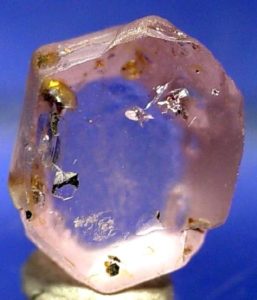 Taaffeite, pronounced “tar-fite”, is a gorgeous and incredibly rare mineral and gemstone. Its color is usually a lilac/mauve but can also appear as a brownish red, pink, purple, bluish green, as well as transparent. Its chemical formula is MgBeAl4O8 and it is made of magnesium, aluminum, beryllium and oxygen. It is classified as an oxide and is part of the hexagonal crystal system. Taaffeite’s Mohs hardness is 8-8.5 and it is currently only used as a gemstone, due to its incredible rarity.
Taaffeite, pronounced “tar-fite”, is a gorgeous and incredibly rare mineral and gemstone. Its color is usually a lilac/mauve but can also appear as a brownish red, pink, purple, bluish green, as well as transparent. Its chemical formula is MgBeAl4O8 and it is made of magnesium, aluminum, beryllium and oxygen. It is classified as an oxide and is part of the hexagonal crystal system. Taaffeite’s Mohs hardness is 8-8.5 and it is currently only used as a gemstone, due to its incredible rarity.
Discovery
The story of its discovery is different from any other gem. It was discovered by Austrian gemologist Richard Taaffee in 1945 as cut and polished gem samples in a jeweler’s shop in Dublin, Ireland. Before Taaffee found this new gem, Taaffeite was wrongly identified as spinel, a group of magnesium aluminum minerals. Taaffe noticed that, unlike spinel, these stones showed signs of double refraction. He took the samples to B.W. Anderson of the Laboratory of the London Chamber of Commerce to identify the stones. It wasn’t until 1951 that a chemical and X-ray analysis showed that taaffeite was not spinel and if fact a new rare gem. It is also the first mineral to contain both beryllium and magnesium as essential components.
Rarity
Since its discovery, only a handful of these stones have been found. There was no new discovery of taaffeite until 1995 when one ovoid pebble was found in southern Tanzania along with other gems such as tourmaline, garnets, and spinel. The pebble was confirmed to be taaffeite. Lower grade taaffeite has been found in China and a few stones have also been found in Sri Lanka. Even though it is one of the top ten rarest gems in the world, its market value is only between $1500-$2500 per carat.
